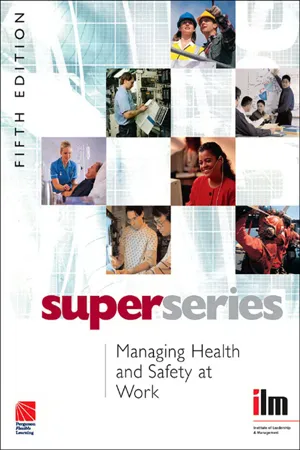Technology & Engineering
Health & Safety at Work Act 1974
The Health and Safety at Work Act 1974 is a key piece of legislation in the UK that outlines the responsibilities of employers to ensure the health, safety, and welfare of their employees at work. It also places duties on employees to take reasonable care of their own health and safety, as well as that of others who may be affected by their actions at work. The Act provides a framework for managing workplace health and safety.
Written by Perlego with AI-assistance
Related key terms
8 Key excerpts on "Health & Safety at Work Act 1974"
- eBook - ePub
- Nikki Booth, Clare Robson, Jacqui Welham, Alison Barnard, Nicki Bartlett(Authors)
- 2009(Publication Date)
- Routledge(Publisher)
Health and Safety at Work, etc Act 1974 (HSWA 1974) provided legal protection to all workplaces. Exposure of vulnerable people to workplace hazards can be identified throughout history and even today there are those who are exposed to risks to their health and safety, albeit in different circumstances to earlier years.3.2 The Health and Safety at Work, etc Act 1974
The HSWA1974 emanated from a committee of six, chaired by Lord Robens. He was chairman of the National Coal Board, a post he held from 1961 until 1972. During that time he had taken to writing personal letters to the widows and mothers of those killed in the pits. During his time deaths at work reduced in number, but he considered that there were still too many accidents. This first hand knowledge and experience provided him with the credentials he needed to chair the committee.The committee determined that there was a need to move away from prescriptive legislation to adopt a self-regulating system, which focused on the need to have better systems of safety organisation, management initiatives and more involvement of the workforce. The emphasis was that with health and safety, good management should be normal management, and that effective management will encompass detailed policy and objectives within an effective organisation. The HSWA 1974 provides the UK with a framework of legislation placing a duty on employers, the self-employed and employees to conduct their activities in such a way that those who could be affected by the activity of the business are not harmed. This extends to those who are not connected with the activities, such as members of the public. The HSWA 1974 - eBook - ePub
- Institute of Leadership & Management(Author)
- 2013(Publication Date)
- Routledge(Publisher)
Until the mid twentieth century, the health and safety of people at work continued to be poorly protected. Legislation was piecemeal, often following specific abuses or disasters.1.1 The Health & Safety At Work, etc. Act 1974
The major turning point came in 1974, with the first comprehensive Health & Safety at Work, etc. Act (HSWA), which imposed a general duty of care on virtually every employer.The Act imposes clear duties on employers relating to health, safety and welfare at work, and also provides guidance on how to promote high standards in these areas. It also imposes obligations on employees to take care for themselves and others who may be affected by their actions.The opening sentence of the Act includes the word ‘welfare’:‘An Act to make further provision for securing the health, safety and welfare of persons at work...’and it is important to keep this third aspect of the Act in mind when you are looking at health and safety issues at your workplace. But we begin with a preface to our subject.2 Introduction to health and safety legislation
We need to start by seeing health and safety in the context of the law in general.2.1 Sources of law
The law applicable in the UK is derived from three principal sources:Although Scottish law has continued to develop along different lines from English law since the Act of Union in 1703, and is partly derived from Scottish common law, all the Acts and regulations we will discuss in this workbook are also applicable in Scotland.statute lawActs of parliament, such as the Health and Safety at Work, etc. Act 1974, together with subordinate legislation (sometimes called ‘statutory instruments’), such as the Management of Health and Safety at Work Regulations 1999.common lawbased on case law – the decisions made in courts over the centuries. Once a judgment is made, a precedent is established. A court is bound to follow earlier decisions made in higher courts, or in courts at the same level.contract lawgoverning agreements between two parties. Contract law does not play much part in health and safety. - eBook - ePub
- Jeremy Stranks(Author)
- 2005(Publication Date)
- Routledge(Publisher)
9 The Criminal ImplicationsThe duties of employers to protect the health of their employees are contained in the Health and Safety at Work etc. Act 1974 and subordinate legislation, such as the Management of Health and Safety at Work Regulations 1999 and the Health and Safety (Display Screen Equipment) Regulations 1992.The principal features of this legislation are outlined below: 9.1 Health and Safety at Work etc. Act 1974 (Hswa) Section 2 Duties of Employers- It shall be the duty of every employer to ensure, so far as is reasonably practicable, the health, safety and welfare at work of all his employees.
- Without prejudice to the generality of an employer’s duty under the preceding subsection, the matters to which that duty extends include in particular:
• the provision and maintenance of plant and systems of work that are, so far as is reasonably practicable, safe and without risks to health;
• arrangements for ensuring, so far as is reasonably practicable, safety and absence of risks to health in connection with the use, handling, storage and transport of articles and substances;
• the provision of such information, instruction, training and supervision as is necessary to ensure, so far as is reasonably practicable, the health and safety at work of his employees;
• so far as is reasonably practicable as regards any place of work under the employer’s control, the maintenance of it in a condition that is safe and without risks to health and the provision and maintenance of means of access to and egress from it that are safe and without such risks;• the provision and maintenance of a safe working environment for his employees that is, so far as is reasonably practicable, safe, without risks to health, and adequate as regards facilities and arrangements for their welfare at work.
Health is not defined in the HSWA or in any regulations made under the HSWA. One definition of health is ‘a state of physical and mental wellbeing’ (International Labour Organization). Under the HSWA and subordinate legislation the criminal liability of an employer in terms of protecting the health of an employee is clear, both generally and specifically. - • Corporate Manslaughter and Corporate Homicide Act 2007 (to be implemented April 2008). In addition to the above list, one of the key pieces of legislation for construction safety is: The Construction (Design and Management) Regulations 2007.2.2 What are the main duties covered by the Health and Safety at Work Etc Act 1974?The Health and Safety at Work Etc Act 1974 is the “underpinning” legislation which governs virtually all other health and safety law. The Act sets out the general parameters of what is expected of employers and other persons in respect of ensuring their health, safety and welfare.Regulations are subsidiary legislation made under the enabling powers of the Health and Safety at Work Etc Act 1974. Contravening Regulations is an offence and prosecutions can be brought regarding each offence. In addition, there may be a breach of the more general principles of health and safety enshrined in the 1974 Act and additional charges could be brought under various sections.The main sections of the 1974 Act are as follows.2.2.1 Section 2 General duty of employers to their employeesIt shall be the duty of every employer to ensure so far as is reasonably practicable, the health, safety and welfare at work of all his employees. ………. the matters to which that duty extends include:
- eBook - ePub
Employment Law
The Essentials
- David Balaban Lewis, Malcolm Sargeant, Ben Schwab(Authors)
- 2023(Publication Date)
- CIPD - Kogan Page(Publisher)
09Health and safety at work
Chapter overview
This chapter outlines UK laws relating to occupational health and safety. It distinguishes between the systems for injury prevention and injury compensation, noting the respective roles of civil and criminal law, common law and statute. The Health and Safety at Work Act 1974 (HASAWA 1974) is explained, together with the role of the Health and Safety Executive (HSE). The broad general duties set out in the Act are introduced, especially those imposed on employers to ensure the health, safety and welfare of their employees while at work and not to put others at risk by their activities. The Management of Health and Safety at Work Regulations 1999 are outlined, and there is a brief description of some of the more important of the other Regulations made under the 1974 Act.LEARNING OUTCOMES After studying this chapter you will have a basic understanding of:- the legal principles contained in both HASAWA 1974 and the regulation-making powers in this Act1
- the legal obligations of duty holders under HASAWA 1974
- the duty to undertake and respond to risk assessments
- the value of working with safety representatives
- the role of the health and safety inspectors
- when it is necessary to obtain expert advice.
9.1 Injury prevention and injury compensation
The primary purpose of the law should be to make work safe so that it does not cause personal injury – but provision also has to be made for the financial support of people who nevertheless suffer injury. ‘Injury’ covers both physical and mental impairment caused by accident or illness. In the UK, the social security system provides income maintenance for those who by reason of sickness, injury or disability are unable to work. In addition, victims may sue in the civil courts for damages (see Chapter 3 , section 3.1.4 ); this aspect of the general law of tort2 has been developed largely through judges deciding the claims of the litigants. Those who sue in respect of work-related injury will claim that the defendant has caused the injury.3 The Employers’ Liability Act 1969 requires employers to have insurance cover to meet damages awarded to employees, for bodily injury but it may not cover harassment as this does not normally lead to physical, as opposed to mental suffering. No insurance is required to cover public liability (liability to those who are not employees, eg a member of the public), but employers will be unwise not to have such cover and also cover for harassment since even innocent employers may be vicariously liable for acts of harassment committed by their employees.4 - eBook - ePub
Key Topics in Healthcare Management
Understanding the Big Picture
- Robert Jones, Fiona Jenkins(Authors)
- 2018(Publication Date)
- CRC Press(Publisher)
In this chapter an overview of the highly complex area of regulating, managing and protecting health, safety and welfare at work has been presented. Health and safety is managed most successfully where its importance is recognised and where it is fully integrated into the mainstream of an organisation’s management functions, delivering a positive health and safety culture across the organisation.A list of suggested further reading is available from a number of organisations, including those representing AHPs and contact details for some are given below.References
1 . www.hse.gov.uk/healthservices/index.htm .2 . www.hse.gov.uk/statistics/industry/healthservices/htm .3 . HSE. A guide to the Reporting of Injuries, Diseases and Dangerous Occurrences Regulations 1995 L73. 2nd ed. London: HSE Books; 1999.4 . Health and Safety at Work Act . London: HMSO; 1974.5 . HSE. Management of Health and Safety at Work Regulations 1999. Approved Code of Practice and Guidance L21 . London: HSE Books; 2000.6 . HSE. 5 Steps to Risk Assessment . London: HSE Books; 2006. www.hse.gov.ukrisk/fivesteps.htm.7 . HSE. Manual Handling Operations Regulations 1992: Guidance on Regulations L23 3rd ed. London: HSE Books; 2004.8 . HSE. Workplace (Health, Safety and Welfare) Regulations 1992. Approved Code of Practice L24. London: HSE Books; 1993.9 . HSE. Health and Safety (Display Screen Equipment) Regulations 1992. Miscellaneous Amendments; Regulations 2002. Guidance on Regulations L26. 2nd ed. London: HSE Books; 2003.10 . HSE. Personal Protective Equipment at Work Regulations 1992. Guidance on Regulations L25. London: HSE Books; 2005.11 . HSE. Provision and Use of Work Equipment Regulations 1998. Approved Code of Practice and Guidance L22. London: HSE Books; 1998.12 . HSE. The Control of Substances Hazardous to Health Regulations 2002 (as amended). Approved Code of Practice and Guidance L5 . 5th ed. London: HSE Books; 2005.13 . Sections 1–4 URN No 06.1908A and Sections 5–11 URN No 06/1908B . London: DTI; 2006.14 . Chartered Society of Physiotherapy. Briefing Paper No 22. The Working Time Regulations 1998. London: CSP; 2002.15 . HSE. Safety Representative and Safety Committees Regulations 1996 L87. - eBook - ePub
- Bridgit C. Dimond(Author)
- 2011(Publication Date)
- Wiley-Blackwell(Publisher)
11 Health and SafetyThe occupational therapist (OT) works in a potentially dangerous environment, whether in a domestic setting or in hospital therapy centres and workshops. This chapter covers the basic principles of law relating to health and safety at work, both statutory provisions and common law duties, taking examples from occupational therapy practice. The following topics are covered:Laws relating to medical devices and the Consumer Protection Act 1987 are considered in Chapter 15 on equipment and those relating to transport in Chapter 16. The Health and Safety at Work etc. Act 1974 (HASAW)- The Health and Safety at Work etc. (HASAW) 1974
- Regulations under HASAW
- The Management of Health and Safety at Work Regulations 1999
- Risk Management and the OT
- Manual Handling Regulations
- Reporting of Injuries, Diseases and Dangerous Occurrences Regulations 1995
- National Patient Safety Agency
- The Occupiers’ Liability Act 1957
- The Occupiers’ Liability Act 1984
- Control of Substances Hazardous to Health Regulations (COSHH) 1988
- The Employers’ Liability (Defective Equipment) Act 1969
- Employers’ Liability (Compulsory Insurance) Act 1969
- Common law duty implied in the contract of employment
- Special areas: cross-infection, animals, violence, stress and bullying, sexual harassment
- Staff health
The Health and Safety at Work etc. Act 1974 (HASAW) is enforced through the criminal courts by the Health and Safety Executive (HSE) and its Inspectorate, which has the power to prosecute for offences under the Act and the Regulations, and which also has powers of inspection and can issue enforcement or prohibition notices. Since the abolition of the Crown’s immunity in relation to the health and safety laws (by the National Health Service (Amendment) Act 1986) prosecutions and notices can be brought against health authorities. Trusts do not enjoy any immunity from prosecution under health and safety legislation. Social services departments can also be prosecuted. - eBook - ePub
Employment Law
The Essentials
- David Balaban Lewis, Malcolm Sargeant(Authors)
- 2019(Publication Date)
- CIPD - Kogan Page(Publisher)
All employers have an obligation to conduct risk assessments. The purpose of this assessment is to identify the measures that must be taken to ensure compliance with the statutory provisions contained in HASAWA 1974, and relevant regulations, taking into account any ACOP or guidance issued by the HSE.- Employers are required not only to carry out but also respond to risk assessments; such assessments should include consideration of stress-related injury.
- COSHH requires employers to prevent or adequately control the exposure of their employees to, and others who may be affected by, hazardous substances.
- There is a duty on employers to provide information to and consult with employees either directly or through their representatives who are either trade-union-appointed or directly elected.
Notes
1 This chapter contains extracts from or close paraphrasing of legislation which is on the opsi.gov.uk website and is subject to crown copyright. The reproduction of this material here is licensed under the open government licence v1.0.2 Most occupational health and safety regulations are made under section 15 of HASAWA 1974 and known as ‘relevant statutory instruments’, although some which represent the implementation of European Directives were made under other legislation and the HSE has been empowered to enforce them too – for example, the Supply of Machinery (Safety) Regulations 2008, SI 2008 No 1597 and the Working Time Regulations 1998, SI 1998 No 833 were made under section 2(2) of the European Communities Act 1972. The Working Time Regulations are covered in Chapter 10 .3
Learn about this page
Index pages curate the most relevant extracts from our library of academic textbooks. They’ve been created using an in-house natural language model (NLM), each adding context and meaning to key research topics.







